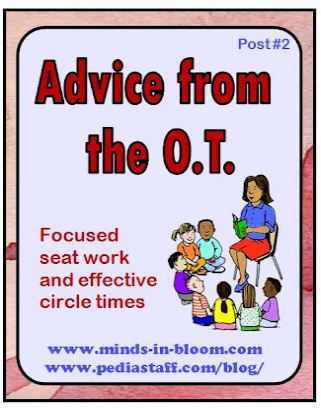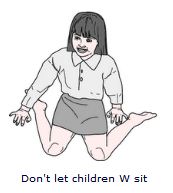Advice from the OT: Why Good Sitting = Good Learning
Editor’s Note: Last week we featured a link to a terrific article on why its so hard for children to sit still, which is the first in a series by PediaStaff columnist Loren Shlaes, OTR/L, being featured on the Rachel Lynette’s prominent general education blog, Minds in Bloom.
Well, I guess the readers over there think Loren is onto something, because that article has already received over 20,000 hits to date! Here is the second installment of Loren’s series – ‘Why Good Sitting = Good Learning.’ On her blog, Rachel introduces Loren’s article this way:
“This second post is all about why is is so very important that children sit properly. It turns out there is much more to sitting than I had ever imagined!”
You bet there is, Rachel, and thank you for the opportunity to share an Occupational Therapist’s perspective with general education teachers through your fantastic blog!

by Loren Shlaes, OTR/L
Posture is Critical to Learning and Attention
If you walked into your office and saw that the top of your desk was so high that it came up to your chin, and your chair was so tall that your legs were dangling, you would immediately go to human resources and demand that it be fixed. Sitting in such ill fitting furniture would prevent you from being able to work. You wouldn’t be comfortable, you couldn’t rest your arms on your desk or your feet on the floor, and you couldn’t really see your computer or your books and papers. But I walk into classrooms all the time and see
exactly that: children sitting with the tops of their work surfaces level with their chins, and their feet not touching the floor.
If children are expected to sit still and pay attention for long periods, the furniture they sit in absolutely must fit! Please, make sure that the table heights in your classroom are about at the height of the bottoms of the children’s ribcages. When they are sitting, shoulders should be relaxed and forearms should be resting comfortably, with elbows bent at a 90 degree angle, on the tops of desks. Chairs should allow feet to sit flatly and firmly on the floor with hips, knees, and ankles bent at 90 degrees.
Tips For Helping Children Sit Up Straight
Sitting still, although it looks easy, is a complex, high level skill. The ability to extend the body effortlessly against gravity, curb impulses, filter out distractions, and focus on a challenging task for long periods of time depends on a high degree of neurological maturity and physical strength and stability.
If a child’s trunk and spine are weak, and he is struggling just to sit up or to sit still, he is using his mental and physical resources in order to comply with the grownups’ demands, and not channeling them into learning his lessons.
There are several things we can do in school to help children maintain good posture and alignment, which will support the work of their hands, eyes, ears, and brains for learning:
- Frequent movement breaks Movement fires the nerve in the inner ear that tells the muscles to extend strongly against gravity, and the brain to alert itself to the environment.
- Make sure the children’s feet are resting flat on the floor There is a mechanism that sends a postural signal to the spine to extend upward when there is pressure on the bottom of the feet.
- Teach children to make sure that their sitting bones are pointing straight down while they are in their chairs. Do you know where your sitting bones are? Put your hand between yourself and the chair, and feel the large, pointy bone in your pelvis that protrudes downwards. When the feet are firmly touching the floor and the sitting bones are pointing directly downwards in the chair, a strong postural signal is sent up the spine.
Unfortunately, many school chairs are designed and constructed so that the chairs are easy to stack and store, rather than with the children’s comfort and posture as a first priority. It is actually difficult to sit in these chairs correctly. Sometimes an easy fix to this is to stick a couple of paperback books under the chair’s hind legs.
You can have the children do some simple postural/alerting exercises before they begin doing handwriting by having them stomp their feet on the floor, lift their arms above their heads,out to the sides, push and pull, then shrug their shoulders up as high as they can, pull them back, and drop.
Managing Circle Time
Many children have a hard time with circle time. Sitting on the floor for extended periods is difficult. Sitting in such close proximity to others without furniture to define personal space can feel threatening. Being forced to sit “criss cross applesauce” for more than a few minutes can be painful, and promotes bad posture. Children often do better sitting on their heels, or lying on their bellies with their elbows propped up, than with their legs crossed in front of them.

If you see a child sitting with his legs straight in front of him and his arms propped up behind him, he is expending so much energy just to stay upright that he has little left over to attend to the lesson. He is sitting that way because his back isn’t strong enough to hold him up. W sitting is harmful to the joints and impedes the child’s development, and should be discouraged. Give the child a chair or have him lie on his belly or sit on his heels instead.
If there are a variety of seating options for circle time, like regular chairs, meditation cushions, and floor chairs like the Nada Chair, the children can choose what will work best for them. For a child who really can’t manage circle time, sitting next to a grown up, a little away from the other children, with his back supported, and a little fidget toy, or even a little activity like lacing or bead stringing to keep his hands busy, is best.
Circle time should be kept short and focused. If you find yourself continually reprimanding the class for not being able to sit still during circle time, it is time to move.
For more valuable information about managing circle time, please see this post on Loren’s blog. If you have a student who really struggles during circle time you may also want to check out, Why Can’t My Child Behave During Circle Time?
Be sure to check out last week’s Advice from the O.T. about why children struggle to sit still.
Next week’s post will be about the importance of recess and PE.
Featured Authors and Websites:
Loren Shlaes is a pediatric occupational therapist who specializes in sensory integration, handwriting remediation and school related issues. She is also a manual therapist and a certified teacher of the Alexander Technique. Her informative blog, PediatricOT won the “favorite resource for therapists” poll conducted by yourtherapysource.com. Her writing has been featured on Parents.com, and she is a regular contributor to the special needs blog at Pediastaff. She is in private practice in Manhattan.
Rachel Lynette (of Minds in Bloom) Rachel Lynette is a former GT teacher and is currently the author of Minds in Bloom, a blog devoted to facilitating creative and critical thinking skills in children. She has also written over 100 nonfiction books for children as well as many resources for teachers. You can find her teaching resources in her Teachers Pay Teachers store.
dup 082319
PediaStaff is Hiring!
All JobsPediaStaff hires pediatric and school-based professionals nationwide for contract assignments of 2 to 12 months. We also help clinics, hospitals, schools, and home health agencies to find and hire these professionals directly. We work with Speech-Language Pathologists, Occupational and Physical Therapists, School Psychologists, and others in pediatric therapy and education.
